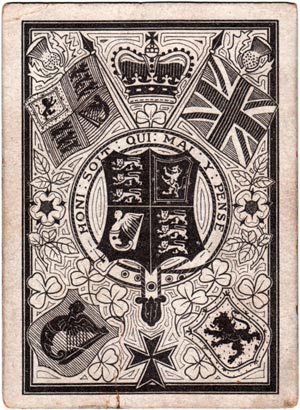Bargains
“Bargains” was designed by George Lambert for C. W. Faulkner & Co in c.1900.
“Bargains” was designed by George Lambert for C. W. Faulkner & Co in c.1900. The game consists of five sets of five in halves, each set bearing the same title, plus one set of six ‘Joker’ cards, making a total of 56 cards.
The five sets are titled as follows: “Ancestral Portrait”, “Household Treasure”, “Domestic Pet”, “Delicious Fruit” and “Landed Estate” but each pair also has a subtitle at the bottom. The six ‘Jokers’ are called “bunkum” cards. The purpose of the game is to pair all the divided cards or the “bunkum” cards by a process of bidding. To see the rules in full click here→


Above: “Bargains”, designed by George Lambert for C. W. Faulkner & Co in c.1900. Hilarious to the Victorians, perhaps, but today these cartoons offer an insight into the wit of his day and a quaint reminder of a different era.
George Lambert was born in Russia in 1873 and came to England in 1878. He went to Australia in 1893 and studied at the Sydney School of Art, where he won a scholarship to Paris. He taught at the London School of Art in 1910 and returned to Australia in 1928 having been elected ARA in 1922. He died on 29th of May in 1930. He contributed illustrations to: The Graphic 1887–88; The Strand Magazine 1891; The English Illustrated Magazine 1893–94, as well as work for Faulkner. From “The Dictionary of British Book Illustrators and Caricaturists”.

By Rex Pitts (1940-2021)
Member since January 30, 2009
Rex's main interest was in card games, because, he said, they were cheap and easy to get hold of in his early days of collecting. He is well known for his extensive knowledge of Pepys games and his book is on the bookshelves of many.
His other interest was non-standard playing cards. He also had collections of sheet music, music CDs, models of London buses, London Transport timetables and maps and other objects that intrigued him.
Rex had a chequered career at school. He was expelled twice, on one occasion for smoking! Despite this he trained as a radio engineer and worked for the BBC in the World Service.
Later he moved into sales and worked for a firm that made all kinds of packaging, a job he enjoyed until his retirement. He became an expert on boxes and would always investigate those that held his cards. He could always recognize a box made for Pepys, which were the same as those of Alf Cooke’s Universal Playing Card Company, who printed the card games. This interest changed into an ability to make and mend boxes, which he did with great dexterity. He loved this kind of handicraft work.
His dexterity of hand and eye soon led to his making card games of his own design. He spent hours and hours carefully cutting them out and colouring them by hand.
Related Articles

Scientific Whist
“Scientific Whist” : standard cards with instructions for play on the faces by Chas Goodall & Son, 1...

Agent Provocateur
Branded lingerie collection in a pack of pin-up playing cards.

Nimbus playing cards
Mike Steer’s weather-themed pack with suits in four colours and backs for cardistry.

Agatha Christie and Playing Cards revisited
Agatha Christie uses card-play as a primary focus of a story, and as a way of creating plots and mot...

The Decadent Deck
Studies in the eroticism of the female body by Inge Clayton.

Historic Shakespeare
“Historic Shakespeare” playing cards featuring Shakespearean characters by Chas Goodall & Son.

Copechat Paramount Sorting System
Preserving the past: a specimen deck showcasing edge-notched cards and their ingenious sorting syste...

Heartsette by Herbert Fitch & Co, 1893
A glimpse into a busy print and design office in late Victorian London.

Rap Rummy
Rap Rummy made by Parker Brothers in 1926, only 4 years after the discovery of King Tutankhamen’s to...

Batman® playing cards
Batman playing cards published by InterCol of London 1989.

Can You Believe Your Eyes?
“Can You Believe Your Eyes?” playing cards featuring visual illusions & other oddities.

Pastime Playing Cards for the Blind
The “Pastime” Playing Cards for the Blind manufactured by Goodall & Son Limd., c.1910.

The European Interchanges Quartets
A card game based around motorway intersections from European countries.

Songs with Flute accompaniment
Eighteenth century English engraved cards with music for voice and flute.

Love Tests
Vintage novelty “Love Test” cards of a slightly saucy nature but all in good fun!

Briefmarken-Quartett
Quartet game featuring postage stamps from the Zones of Occupation in post-WWII Germany.
Most Popular
Our top articles from the past 28 days

